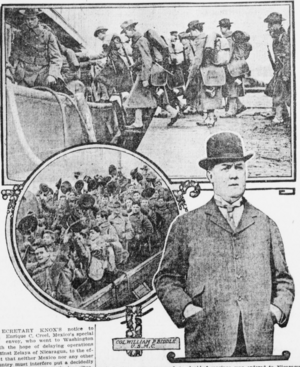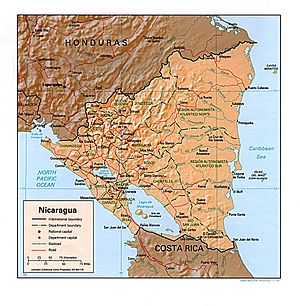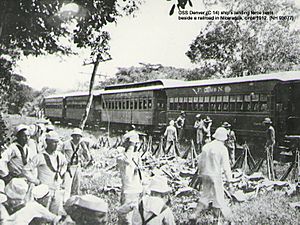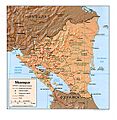United States occupation of Nicaragua facts for kids
Quick facts for kids United States occupation of Nicaragua |
|||||||
|---|---|---|---|---|---|---|---|
| Part of the Banana Wars | |||||||
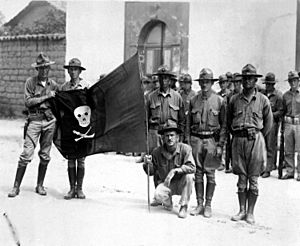 United States Marines with the captured flag of Augusto C. Sandino in 1932 |
|||||||
|
|||||||
| Belligerents | |||||||
(1927–1933) |
|||||||
| Commanders and leaders | |||||||
| Casualties and losses | |||||||
| First occupation (1912–1925): 7 killed (5 marines & 2 sailors) 16 marines wounded (all in 1912) Second occupation (1926–1933): 136 marines killed (32 killed-in-action, 15 died of wounds, and 5 murdered by mutinous National Guardsmen) 75 killed (Nicaraguan National Guardsmen) |
First occupation (1912–1925): unknown Second occupation (1926–1933): 1,115 killed (presumably Sandinistas. This number may have been inflated) |
||||||
The United States occupation of Nicaragua happened from 1912 to 1933. It was part of the Banana Wars, a time when the U.S. military got involved in different countries in Latin America. The main reason for the U.S. presence in Nicaragua was to stop any other country from building a canal there. The U.S. wanted to control any future canal.
Nicaragua became like a protectorate (a country controlled and protected by a stronger one) under the 1916 Bryan–Chamorro Treaty. President Herbert Hoover (1929–1933) later decided this arrangement was not good. So, on January 2, 1933, the U.S. ended its military presence in Nicaragua.
Contents
Why Did the U.S. Get Involved in Nicaragua?
Early Conflicts and U.S. Influence (1909)
In 1909, Nicaragua's President José Santos Zelaya faced a challenge. The Conservative Party, led by Juan José Estrada, wanted to overthrow him. Estrada received help from American business people. They hoped to gain economic benefits if Estrada won.
The U.S. had a small military presence, mainly a Navy ship, near the coast. This ship was there to protect American citizens and their businesses. Estrada's rebellion started in December 1909. Two Americans, Leonard Groce and Lee Roy Cannon, were captured. President Zelaya ordered them to be executed. This event caused a serious break in relations with the U.S.
U.S. Navy ships moved into position near Nicaragua. These included the USS Des Moines (CL-17), USS Tacoma (CL-20), and USS Hannibal (AG-1). Other ships like USS Albany (CL-23) and USS Yorktown (PG-1) also arrived. They were supposedly there to protect American citizens and property.
President Zelaya resigned on December 14, 1909. His chosen successor, Jose Madriz, was elected. However, U.S. Secretary of State Philander C. Knox said the U.S. would not recognize Madriz's government. He wanted Madriz to fix the problems caused to American citizens. Zelaya left Nicaragua on a Mexican ship.
For the next five months, U.S. ships stayed near Nicaragua. They tried to remain neutral in the ongoing conflict. By March 1910, the rebellion seemed to be ending. The U.S. ships then left Nicaraguan waters.
In May 1910, U.S. Marine Corps Major Smedley Butler arrived with 250 Marines. They were there to provide security in Bluefields. Secretary of State Knox supported Estrada. Zelaya eventually left the country due to U.S. pressure. José Madriz became president but also resigned. In August 1910, Juan Estrada became president with U.S. support.
Mena's Rebellion and Dollar Diplomacy (1912)
President William Howard Taft and Secretary of State Philander C. Knox used a policy called Dollar Diplomacy. This policy aimed to reduce European financial power in the region. It also protected American investments in Nicaragua's natural resources. American banks started lending money to Nicaragua. This gave the U.S. control over the country's money matters.
By 1912, political conflict in Nicaragua grew worse. U.S. investments were at risk. General Luis Mena, the Minister of War, forced President Estrada to resign. Adolfo Díaz became president.
Díaz was seen as too close to the U.S. This made him unpopular. Many Nicaraguans, including Luis Mena, felt strongly about their country's independence. Mena gained support by saying Díaz was "selling out the nation." When Mena's opposition turned into a rebellion, Díaz asked the U.S. for help. Knox told President Taft that the Nicaraguan railway was in danger. This railway was important for U.S. interests.
In mid-1912, Mena tried to become president after Díaz's term. The U.S. did not agree with this. So, Mena rebelled against Díaz. A Liberal general, Benjamín Zeledón, joined Mena. Their main base was in Granada.
Díaz asked the U.S. to intervene. He said he could not protect U.S. citizens and property. In August 1912, Mena's forces took control of steamers on Lakes Managua and Nicaragua. These ships belonged to a U.S.-managed railroad company. Rebels also attacked the capital, Managua. The U.S. minister asked Washington to send troops to protect the U.S. embassy.
The U.S. sent more Marines. Smedley Butler returned from Panama with 350 Marines. The overall commander was Admiral William Henry Hudson Southerland. Their main goal was to secure the railroad from Corinto to Managua.
The 1912 U.S. Occupation of Nicaragua
On August 4, 1912, 100 U.S. Navy sailors landed in Managua. They were there to protect American citizens and the U.S. embassy. On the east coast, the USS Tacoma (CL-20) landed 50 men in Bluefields. On August 15, 350 U.S. Marines arrived in Managua. More ships, including the USS Denver (CL-16), arrived in Corinto.
Admiral Southerland's main goal was to secure the railway and communication lines. These ran between Corinto, the main port, and Managua. On August 29, 120 men from the USS Denver landed in Corinto. They protected the railway line. Other small groups of U.S. forces were also sent to protect important locations.
On September 22, Marines under Major Smedley Butler entered Granada. They were joined by Colonel Joseph H. Pendleton and his Marines. General Mena, who started the rebellion, surrendered his 700 troops. He was sent to Panama.
Rebel forces under Zeledón occupied two hills, Barranca and Coyotepe. These hills overlooked the railway line at Masaya. Nicaraguan government forces attacked these hills. On October 2, Zeledón refused to surrender. Admiral Southerland ordered the Marines to take the hills.
On October 3, Butler's Marines attacked the hills with artillery. In the early morning of October 4, U.S. Marines moved up Coyotepe hill. They captured the rebels' artillery and used it against them. Zeledón and most of his men fled. They were later captured or killed by Nicaraguan government troops.
With the rebels defeated, U.S. forces occupied Leon. This was the last rebel stronghold. The revolution was largely over.
By October 23, most of the U.S. forces began to leave. About 2,350 U.S. Marines and sailors had been involved. Only 100 Marines remained in Managua to guard the U.S. embassy. Thirty-seven U.S. military members died during this intervention.
The Knox-Castrillo Treaty of 1911 gave the U.S. control over much of Nicaragua's financial system. In 1916, General Emiliano Chamorro Vargas became president. He continued to attract foreign investment. Some Marines stayed in Nicaragua after the main intervention.
The 1927 U.S. Occupation and Sandino
A civil war started on May 2, 1926. Liberals captured Bluefields and Puerto Cabezas. Juan Bautista Sacasa declared himself president. After Emiliano Chamorro Vargas resigned, Adolfo Diaz became president. Díaz asked U.S. President Calvin Coolidge for help. On January 24, 1927, 400 U.S. Marines arrived.
Government forces faced defeats. U.S. Marines landed in Corinto and occupied La Loma Fort in Managua. By March, the U.S. had 2,000 troops in Nicaragua.
In May, Henry Stimson helped create a peace deal. It included disarming the fighters and promised elections in 1928. However, a Liberal commander named Augusto César Sandino refused to give up. He and 200 of his men continued the fight.
On June 30, Sandino took over the San Albino gold mine. He spoke out against the government and gained more followers. The next month, the Battle of Ocotal took place. Despite more fighting with Sandino's rebels, U.S.-supervised elections were held in November 1928. Moncada won the election.
By 1930, Sandino's rebel forces grew to more than 5,000 men. The Hoover administration began to pull out U.S. troops. By February 1932, only 745 men remained. Juan Sacasa was elected president in November 1932. The Battle of El Sauce was the last major fight of the U.S. intervention.
Images for kids
See also
 In Spanish: Ocupación estadounidense de Nicaragua para niños
In Spanish: Ocupación estadounidense de Nicaragua para niños


